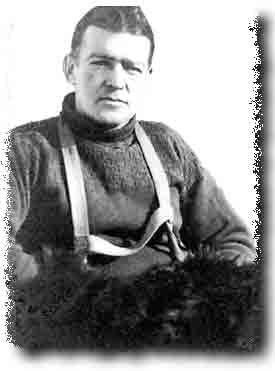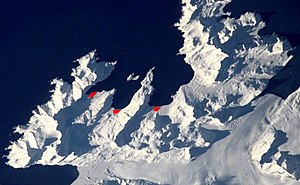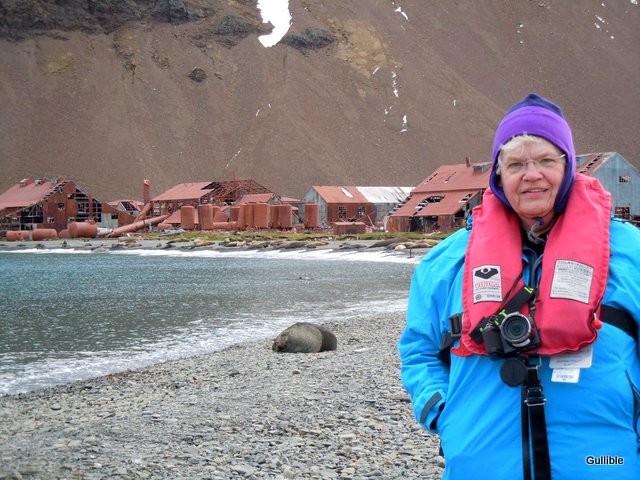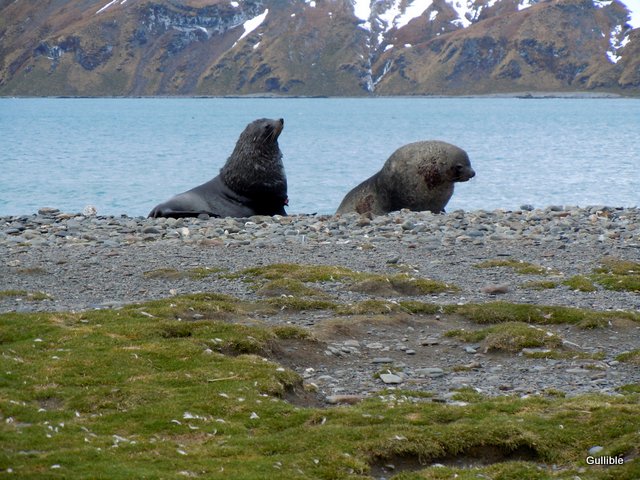"I'm going to speak my mind because I have nothing to lose."--S.I. Hayakawa
Monday, December 31, 2012
Sunday, December 30, 2012
The Antarctic Journals, Chapter Twenty-one, Drifting Ice and Stromness
Monotony, boredom, and the dwindling food supply settles on
the men of Endurance in Camp Patience. Thomas
Orde-Lees, in charge of supplies, frantically inventories again and again with
the dire prediction that there is only a month’s worth left.
Seals and penguins are scarce on this unstable, slushy
ice. One Jan. 27, 1916, 27 dogs are shot
as they are no longer useful and their pemmican feed is saved for human
consumption. Two men make a dangerous
trip to Ocean Camp and salvage 900 pounds of supplies.
The scarcity of seals and penguins means little fuel for
their blubber stove so hot food is limited to one cup of tea in the
morning.
 |
| Shackleton in leather traces used for dragging life boats across the pack ice. |
A flock of Adelie penguins appears near the end of February
and 300 are taken for food. Their
fat-rich skins are used for fuel. Almost
all the provisions are exhausted and meals consist primarily of penguin meat. Cocoa is gone, tea and flour almost depleted.
The austral winter approaches and the weather turns
bad. Blizzards, gales, and cold bring even
worse conditions to starving men already suffering from wet and freezing
clothing and sleeping bags.
The red line shows where Endurance became trapped in the ice of the Weddell Sea and the men set up camp on the pack ice. The line then turns white, showing the drift and rotation of the ice where the men are stranded.
***
 Access to the Fram’s bridge is on Deck Six, the same deck
where my cabin is located. Occasionally,
I meet one of the ship’s officers leaving the bridge after his watch. The day after "The Storm," as it becomes
known, we meet in the companionway.
Access to the Fram’s bridge is on Deck Six, the same deck
where my cabin is located. Occasionally,
I meet one of the ship’s officers leaving the bridge after his watch. The day after "The Storm," as it becomes
known, we meet in the companionway.
“On a scale of one to ten,” I ask, “How does that storm rank in your experience?” He pauses and I’m wondering if he’s thinking
about other storms he’s encountered or searching for a passenger-correct answer.
“Nine,” he says. That’s a good answer, although I admit I wished he’d said 11 or 12. While we did get hit with some
hurricane-force gusts, they weren’t sustained at that force.
This afternoon’s landing is at Stromness, just a 16 mile
jaunt around a point of land to another bay called, appropriately,
Stromness. Again Fram anchors in calming water. From the ship, we see ruins
of a whaling station built in 1912. It operated
for a couple decades before its conversion into a ship repair station.
 |
| Stromness is the center red spot. Fortuna Bay is at the top right corner of the photo. |
The Polarcirkle boat lands us away from the ruins and we are
instructed to avoid them as they are unstable and might contain hazardous
material such as asbestos.
There are seals everywhere. They line the beach and lumber far inland over
mossy humps and across muddy drainages. Gentoo
penguins and King penguins travel back and forth, oblivious to the seals and
tourists.
These journals will return to Stromness a few chapters hence
as this valley figures large in our adventure.
 |
| Male Antarctic fur seals can weigh up to 460 lbs and be 6.5 feet long. Females weigh considerably less. |
Now though, Fram
anchors here for the night, a treat after several days of rough and rougher
water. We walk about the ship normally, climb stairs the way they are supposed to be climbed, and both elevators are
operational.
No one is likely to be thrown out of bed tonight.
 |
| This guy chose this position. He didn't get tossed there. |
 |
| Gentoo penguins, identifiable by the white band across the top of their heads. |
 |
| Adult King penguin. Immature but fledged King penguins have a yellow ear patch that eventually turns orange. |
 |
| Gully and seals at Stromness |
 |
| This is the first iceberg we've seen. All those lumps on the land are seals. |
 |
| We found it impossible to stay 15 feet away from the penguins. Instead, we stood still when they approached. |
 |
| Gentoo penguins on a mission march. |
 |
| Male fur seals are known to attack humans when they become territorial as breeding season approaches. This Orange Person holds a broomstick in case the seal needs to be dispelled of any such notions. |
 |
| Too early in the season, apparently, as this male fur seal doesn't seem to care. An Orange Person with a broomstick would be stationed near any male fur seals in our path. |
 |
| Back aboard Fram, the boot battle continues for some. |
 |
| For others, the boots come off all too easily, especially when stuck in the mud at Stromness. |
The Antarctic Journals, Chapter Twenty, Fortunes
Chippy McNish returns to the wreck of Endurance and removes the entire wheelhouse so it can be used as
a storehouse at Ocean Camp. When he chops
through the deck, cases of provisions float up and are salvaged.
Photographer Frank Hurley makes a trip to the ship and later
wrote in his diary, “I hacked through the thick walls…to retrieve negatives… They were located beneath four feet of mushy ice
& by stripping to the waist & diving under I hauled them out. Fortunately they are soldered up in double tin
linings, so I am hopeful they may not have suffered by their submersion.”
When Hurley returns to camp, Ernest Shackleton relents and
allows Hurley to exceed his personal weight limit of two pounds. He and Hurley sort through the negatives,
keeping 100 and dumping about 400.
Shackleton had previously sold the story rights to the expedition and now
determines that Hurley’s photographs will be valuable.
With warming temperatures of the austral summer, the surface
of the ice turns slushy.
On the evening of Nov. 21, the men hear Shackleton call, “She’s
going.” In the distance, Endurance sinks bow first into the ocean.
By mid-December the camp on the pack ice has drifted north
across the Antarctic Circle, but a few days later the wind shifts and drives
them back. Shackleton decides to attempt
another push toward land and an arduous trek begins on Dec. 23. After eight hours of incredible labor, the
group progresses only a mile and a half.
 |
| The men of the Endurance hauling one of the life boats across the Antarctic pack ice. |
Trouble arises.
Carpenter McNish, suffering from piles and still heartsick at the loss
of his cat, Mrs. Chippy, tells Shackleton that his duty to follow orders
terminated with the loss of the ship.
The Boss, as Shackleton is known, calls the men together and reads the
ship’s articles.
He then adds that the men will be paid until they reach a
safe port, a complete variation of normal ship’s articles. This, he says, makes the men bound by his
orders until that time. Morale is at a
dangerous low and when Shackleton reluctantly calls a halt to the march two
days later, they must retreat a half mile to stronger ice.
 |
| The galley at the new Patience Camp, February, 1916. |
After eight back-breaking days, the men find themselves
setting up a new camp on dangerously unstable ice. They are now cut off from Ocean Camp, where
lumber for tent floors, books, an efficient cook stove, and many provisions
were left.
Black and white photos above by Frank Hurley, courtesy of:
-
South with Endurance: Shackleton's Antarctic Expedition 1914-1917
The Photographs of Frank Hurley
Book Creation Services, Ltd., London, 2001
ISBN 1-932302-04-2
***
I wake up in a beautiful bay, the Fram rocking gently on choppy waters trying to calm after the big
ruckus during the night that threw passengers out of bed.
The clouds have cleared and the skies are blue. Perfect day for a landing on one of the most
remote places on earth, and our first is here in Fortuna Bay, on the leeward
northeastern side of the island.
It is also here that I once again stumble across the
footprints of famed British explorer Captain James Cook, who charted and
described this island. The first place I
found him was in the place where I grew up—Anchorage, Alaska.
Back in the 1700s, Cook sent his boat captain, William Bligh
(yes, THAT Bligh), up one of two arms of an inlet now called Cook Inlet. Bligh, realizing this arm was not a
throughway to the elusive Northwest Passage, named this one Turnagain
Arm. Cook later sailed south to the
Hawaiian Islands, meeting his end at the hands of the natives there.
While Cook found little potential in South Georgia island,
his notes about the numerous seals resulted in commercial endeavors by sealers
from Britain and the United States. In
1904, a Norwegian company established the first whaling station at Grytviken
(grit-VICK-en), a few miles from here.
Watch this video very carefully, especially the last two penguins in line. When the forward one stops to preen itself, take note of what the last one does. It happens quickly, about 9 seconds into the video.
One hundred and four miles long by .9 to 23 miles wide, South Georgia has six peaks rising more than 6500 feet. The tallest, Mount Paget, measures 9,626 feet. The South Sandwich Islands also are part of South Georgia, and together the land mass is but 1507 square miles. Glaciers cover fifty-seven per cent of the island.
 |
| King penguins and tourists. Breakwind Mountains in background. |
Strict measures are in place for landing on the island,
including the afore-mentioned vacuuming
of the clothing we were going to wear, in an effort to avoid introduction of
organic material including animals, plants, seeds, soil, and diseases. In addition to the usual boot wash station on
the ship’s platform where we board and get off the Polarcirkle boats, a
sanitizing boot bath is added. It is
simply a chunk of wet foam rubber in a small square well containing a
sanitizing liquid in which we step.
 |
| The King penguin welcoming committee. |
Once we get to shore, we walk past the elephant and fur
seals to a huge King penguin colony near a glacier. Ninety-five percent of the Antarctic fur
seals breed here, and half the world population of Southern elephant
seals. Millions of penguins and other
sea birds nest here, including 250,000 albatross and the spectacular Wandering
albatross with a wingspan of about ten feet.
 |
| King penguin and furry chick. |
 |
| King penguin chick follows a parent, begging for food. |
This is a video of the hungry (above) chick and its parent. The chick makes high-pitched noises like songbirds.
Though asked to stay five yards from the penguins, somebody
forgot to tell the penguins. They didn’t
seem to care at all that we were there, or perhaps they are used to the summer
influx of tourists that is fast becoming a significant economic factor. Fishing is first, accounting for 90 percent
of the revenues.
There is much history here and Ernest Shackleton is right in
the middle of it, as we shall see in later journals.
 |
| Penguin highway. |
 |
| The larger seal is a male elephant seal, with a huge proboscis. |
 |
| Fur seal and King penguin |
 |
| These two fur seals were fighting immediately before this photo was taken. The seal on the left has a patch of hide torn loose just above its front flipper. |
 |
| Penguin tracks in snow. |
 |
| First of four photos that are part of a panoramic view of the King penguin rookery at Fortuna Bay. |
 |
| What? |
Subscribe to:
Posts (Atom)


























